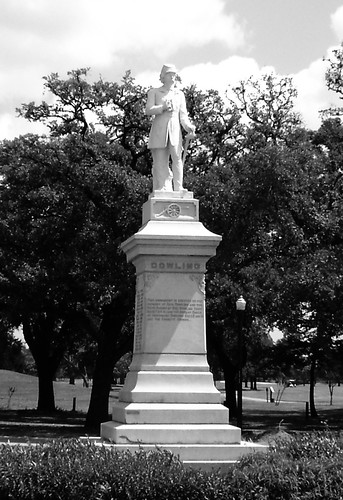In class today we developed a rough outline of sections for our exhibits. But now we need to do a quick analysis of how the “items” in our collection might be distributed across those sections. Not every item in the collection has to be mentioned in our exhibit, but we do need a sense of which items could conceivably be used in each section so that we can decide how to break the sections up into pages.
Since we will need to make that decision on Wednesday, your assignment for class is to browse through the collection and make a note of items relevant to the section you were assigned in class. Then, make a list of those items, together with a brief (just a few words) description of what the item is, on this Writeboard, which you can access using “dowling” as the password.
Here’s what we had on the board by the end of class:
Abby suggested that we open the exhibit by juxtaposing Jefferson Davis’s battlefield speech with the text of the historical marker erected in the 1990s and posing the question “How did we get here?” (It occurs to me that we could also on this splash page juxtapose the original location of the statue with its current one, which raises the same sort of question.)
After that we came up with three rough sections:
1. Elizabeth and Clare will be finding items related to “The Battle of Sabine Pass: What actually happened.” This section may also reference the facts of Dowling’s life, but we agreed that his business enterprises and Irish ethnicity would probably be better emphasized in later sections, when discussing how later commemorations emphasized these parts of his life.
2. Abby, Matt, and Michael will be finding items related to the way Dowling was remembered in the immediate aftermath of the Battle up to the early twentieth century, for a section that will emphasize how Dowling was remembered as a Confederate hero and the initial construction of the statue.
3. Adam and Zach will be finding items related to those who were interested in remembering Dowling from about 1958 on, especially Anne Caraway Ivins, for a section that will help contextualized and explain the movement towards emphasizing his Irishnessness and business exploits and deemphasizing his Confederate service.
You may wish to confer with your group members to divide the labor for Wednesday. Also be aware that if you find only a few items that seem relevant in the actual Omeka collection, there may be relevant items that we could import into the exhibit listed on or linked from this page.
On Wednesday, using the information on the Writeboard, we will finalize the organization of our exhibit and assign pages to work on during the last week of class.



 Monday’s reading is from one of our required books for the semester, Thomas J. Brown’s The Public Art of Civil War Commemoration. The assigned pages (pp. 1-55, 79-108) cover a wide range of documents and themes related to how people have commemorated the war in the past and how it is remembered today.
Monday’s reading is from one of our required books for the semester, Thomas J. Brown’s The Public Art of Civil War Commemoration. The assigned pages (pp. 1-55, 79-108) cover a wide range of documents and themes related to how people have commemorated the war in the past and how it is remembered today.
Levine Discussion
I forgot to mention in class today that there may be some high school students joining us in class next Wednesday for our discussion of Levine. They are from Carnegie Vanguard High School in Houston and will be visiting Rice with their class to check out a college course.
For your required comment on this book, I would like you to write something addressing ONE of the following prompts, based on your reading of the Levine book:
Optionally, after addressing your prompt, you may also use your post to discuss anything that you found surprising, confusing, or particularly interesting about the book. I believe it is the Brownians’ turn to comment before class.